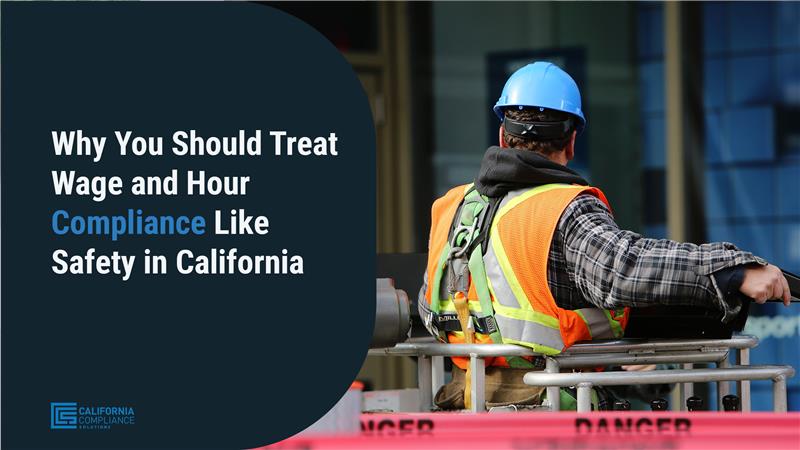You have probably known for a long time that California businesses must comply with the state’s workplace safety and health laws. The California Division of Occupational Safety and Health (Cal/OSHA) oversees and enforces these laws and regulations, which came about in the 1970s. Failing to adhere to these laws can result in considerable penalties. General violations can be over $12,000 per violation, serious violations over $25,000 per violation, and willful or repeat violations over $100,000 per violation.
To increase worker safety and avoid such crushing penalties, businesses all over the state have created elaborate safety programs and injury and illness prevention programs. These programs often involve extensive safety training and written policies for employees; weekly or daily check-in meetings; inspection and monitoring; clever accountability systems and incentive programs to encourage safety; prominently displayed posters, signs, and creatively written reminders; and elaborate record keeping. Thanks to years of adoption, development, and faithful implementation by most California businesses, these programs have significantly reduced the threat of legal action for most employers. While there will always be a degree of risk in the safety arena, the risk is well managed through these prevention programs. For that reason, most employers can sleep easy knowing safety lawsuits are unlikely to threaten the existence of their business.

Wage and Hour Issues Are an Equal or Greater Threat
Contrast this with the risk wage and hour lawsuits pose to California businesses. Although California’s wage and hour laws don’t threaten employees’ physical health and well-being like safety issues do, they still threaten the health and well-being of businesses. Simply put, wage and hour lawsuits are a far greater legal and financial threat to employers in California than safety issues.
When did you last hear of a business paying millions to resolve a safety issue? While multi-million-dollar judgments and settlements are rare in the safety context, they are routine in the wage and hour context. In 2022 alone, the top ten class and collective action settlements in the wage and hour space nationally totaled $574.55 million, with half of the top ten settlements approved by federal or state courts in California. The significance of wage and hour issues (such as missed meal and rest periods, incomplete paystubs, improper overtime pay rate, etc.) is often overlooked because they don’t directly affect worker health; nonetheless, California’s wage and hour laws are structured to make penalties more severe than they are for safety violations.
Donohue Delivers Serious Implications
In 2021, the California Supreme Court’s decision in Donohue v. AMN Services indicated that companies must treat wage and hour compliance like a health and safety issue. On the surface, there were two main takeaways from the decision:
- Rounding of meal periods is unlawful.
- Employers must prove that lawful meal periods are taken.
The Donohue decision’s more profound implication, however, was a shift in the burden of proof in wage and hour cases from employees to employers—meaning that any evidence (like a timecard) showing a meal break violation is now legally presumed to be the fault of the employer unless there is direct and specific evidence to the contrary.
It’s apparent that California employers must police wage and hour issues like safety issues but suffer more severe consequences.
The Cost of Wage and Hour Lawsuits Far Exceed Safety
Putting the insanity of that notion aside (that wage and hour compliance is more important to California than worker safety), it is reality, nonetheless. If you are skeptical, here are a few examples.
In the last few years alone:
- Major League Baseball was hit with a $185 million settlement for violating state and federal wage laws.
- ABM Industries settled for $140 million for inaccurate time records.
- Wal-Mart suffered a $101 million judgment for paystub violations.
- DoorDash settled for $100 million due to drivers being misclassified as contractors instead of employees.
- Equinox Holdings settled multiple cases in both Federal and California State Court for $36 million.
- McDonald’s settled a wage and hour class action for $26 million.
- Kaiser Permanente? $20 million. Target? $14 million. Safeway? $12 million. Abercrombie & Fitch? $9.6 million. And Allstate? $5.5 million.

The list continues, and this is just the tip of the iceberg. Small and large businesses have paid out thousands of high six-figure or seven-figure settlements in wage and hour cases in recent years, plus their own attorneys’ fees, which are often in the six figures in these cases. It is safe to say that these companies spent exponentially more on wage and hour issues than on safety.
How can it be that potential liability caused by, for example, unintentional errors on employees’ paystubs or employees’ failures to take compliant breaks can dwarf the liability from serious safety violations? There are at least four reasons, which we will discuss in part two of our five-part series.

